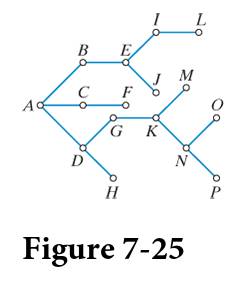
Consider the tree shown in.
a. How many degrees of separation are there between
b. How many degrees of separation are there between
c. How many degrees of separation are there between
d. What is the diameter of the network?

Want to see the full answer?
Check out a sample textbook solution
Chapter 7 Solutions
MYLAB MATH FOR EXCURSIONS IN MATHEMATIC
Additional Math Textbook Solutions
Pathways To Math Literacy (looseleaf)
Finite Mathematics for Business, Economics, Life Sciences and Social Sciences
Elementary Statistics: Picturing the World (7th Edition)
Elementary Statistics
University Calculus: Early Transcendentals (4th Edition)
- 4. Solve the system of equations and express your solution using vectors. 2x1 +5x2+x3 + 3x4 = 9 -x2+x3 + x4 = 1 -x1-6x2+3x3 + 2x4 = -1arrow_forward3. Simplify the matrix expression A(A-B) - (A+B)B-2(A - B)2 + (A + B) 2arrow_forward[2 pts] 1. Let A = [. 1 -1 0 -343 and B = 05 5 -7 304 Compute (7A - 3B) - 4(2A - B).arrow_forward
- 20 2. Let A = = [ -2 0 1 3 ] and B = 2 3 -1 2 For each of the following, calculate the product or indicate why it is undefined: (a) AB (b) BAarrow_forwardTrue or False and whyarrow_forward10 5 Obtain by multiplying matrices the composite coordinate transformation of two transformations, first x' = (x + y√√2+2)/2 y' = z' (x√√2-2√2)/2 z = (-x+y√√2-2)/2 followed by x" = (x'√√2+z'√√2)/2 y" = (-x'y'√√2+2')/2 z" = (x'y'√√2-2')/2.arrow_forward
- Not use ai pleasearrow_forward4 The plane 2x+3y+ 6z = 6 intersects the coordinate axes at P, Q, and R, forming a triangle. Draw a figure and identify the three points on it. Also find vectors PQ and PR. Write a vector formula for the area of the triangle PQR and find its value.arrow_forward3.1 Limits 1. If lim f(x)=-6 and lim f(x)=5, then lim f(x). Explain your choice. x+3° x+3* x+3 (a) Is 5 (c) Does not exist (b) is 6 (d) is infinitearrow_forward
- 1 pts Let F and G be vector fields such that ▼ × F(0, 0, 0) = (0.76, -9.78, 3.29), G(0, 0, 0) = (−3.99, 6.15, 2.94), and G is irrotational. Then sin(5V (F × G)) at (0, 0, 0) is Question 1 -0.246 0.072 -0.934 0.478 -0.914 -0.855 0.710 0.262 .arrow_forwardAnswer the number questions with the following answers +/- 2 sqrt(2) +/- i sqrt(6) (-3 +/-3 i sqrt(3))/4 +/-1 +/- sqrt(6) +/- 2/3 sqrt(3) 4 -3 +/- 3 i sqrt(3)arrow_forward2. Answer the following questions. (A) [50%] Given the vector field F(x, y, z) = (x²y, e", yz²), verify the differential identity Vx (VF) V(V •F) - V²F (B) [50%] Remark. You are confined to use the differential identities. Let u and v be scalar fields, and F be a vector field given by F = (Vu) x (Vv) (i) Show that F is solenoidal (or incompressible). (ii) Show that G = (uvv – vVu) is a vector potential for F.arrow_forward
 Elementary Geometry For College Students, 7eGeometryISBN:9781337614085Author:Alexander, Daniel C.; Koeberlein, Geralyn M.Publisher:Cengage,
Elementary Geometry For College Students, 7eGeometryISBN:9781337614085Author:Alexander, Daniel C.; Koeberlein, Geralyn M.Publisher:Cengage, Elementary Geometry for College StudentsGeometryISBN:9781285195698Author:Daniel C. Alexander, Geralyn M. KoeberleinPublisher:Cengage Learning
Elementary Geometry for College StudentsGeometryISBN:9781285195698Author:Daniel C. Alexander, Geralyn M. KoeberleinPublisher:Cengage Learning Mathematics For Machine TechnologyAdvanced MathISBN:9781337798310Author:Peterson, John.Publisher:Cengage Learning,
Mathematics For Machine TechnologyAdvanced MathISBN:9781337798310Author:Peterson, John.Publisher:Cengage Learning, Algebra: Structure And Method, Book 1AlgebraISBN:9780395977224Author:Richard G. Brown, Mary P. Dolciani, Robert H. Sorgenfrey, William L. ColePublisher:McDougal Littell
Algebra: Structure And Method, Book 1AlgebraISBN:9780395977224Author:Richard G. Brown, Mary P. Dolciani, Robert H. Sorgenfrey, William L. ColePublisher:McDougal Littell Linear Algebra: A Modern IntroductionAlgebraISBN:9781285463247Author:David PoolePublisher:Cengage Learning
Linear Algebra: A Modern IntroductionAlgebraISBN:9781285463247Author:David PoolePublisher:Cengage Learning Glencoe Algebra 1, Student Edition, 9780079039897...AlgebraISBN:9780079039897Author:CarterPublisher:McGraw Hill
Glencoe Algebra 1, Student Edition, 9780079039897...AlgebraISBN:9780079039897Author:CarterPublisher:McGraw Hill





